|
|
Posted By Admin,
Thursday, June 8, 2023
|
By Gerry Donaldson
November 2, 2019
Discover the resource in detecting and managing common pests in conifers.
Imagine your landscape with seventy percent, or more, of the plants dead! Imagine all of your community similarly affected! Imagine all of your state, all of your USDA growing zone, possibly all of your country affected!
No, this is not an introduction to an episode of Twilight Zone, and granted, this may sound alarmist, but such loses are a very real possibility if invasive insects and/or diseases have their way with our natural and built landscapes.
The Effects of Conifer Invasive Pests
Each loss in our landscapes results in changes in the ecosystem. All of the components of an ecosystem work together to clean water and to re-charge aquifers. They clean air and provide oxygen, moderate atmospheric temperatures and provide habitat
for the complex web of life. All of this facilitates human survival.
Invasive pests wreak havoc on those ecosystems at a cost greater than 25 billion dollars in damaged or lost crops and forest products annually. Reduced property values
and increased maintenance costs are direct costs to homeowners and all taxpayers, adding billions more.
The U.S. Government, through the USDA’s Animal and Plant Health Inspection Service (APHIS), works to keep invasive pests out of our country. We all know of examples where that effort has fallen short. Think about chestnut blight, which devastated the American chestnut in the late 1800’s and early 1900’s. In some areas, the American chestnut was up to 20% of the trees in forests and provided a significant food source for Native Americans, early settlers, and the animals of the forest.
In the 1920’s, Dutch elm disease was identified in the United States. By the 1960’s, it had virtually wiped out the American elm throughout North America, dramatically changing our forests and city streets.
More recently, in 2002, emerald ash borer was discovered in the US. Since that time, it has devastated the ash trees of the Great Lakes region and has spread to 30 states, killing millions of trees and costing billions of dollars in loss and damage.
Early Detection of Conifer Pests
The importance of early detection is exemplified by the emerald ash borer experience. Initial homeowner questions about what was happening with their ash trees were met with confusion on the part of arborists and in extension, university personnel,
due to lack of knowledge of the insect. Little, if any prescriptive information was available. By the time the insect was identified and researchers had identified controls, the area infested had become so large that elimination was ruled out as a
possibility.
Early detection of invasive species is critical if we intend to prevent future disasters. The longer an invasive goes undetected, the more difficult, and more expensive it is to control (see Invasive Introduction Curve). Fortunately, a
plan to combat invasive species is in place and is beginning to have a positive effect.
This post has not been tagged.
Permalink
|
|
|
Posted By Admin,
Thursday, June 8, 2023
|
By Web Editor
January 26, 2020

Spring new growth on Picea pungens 'Gabelle's Golden Spring'
Confessions of a Reformed Perennialista
I made my first garden when I was nine years old, and, but for a few years off here and there when I lived in cities, I have been gardening ever since. I have gone through gardening phases of all kinds: from Heuchera to Helleborus, from English cottage to Mediterranean, from sweet peas to sourwood. Each season seemed to bring a new book or plant introduction that would dominate my gardening focus for a while.
My gardens have always been nice, have always been admired and, for most of my life, have always satisfied me. Like most people, I grew primarily herbaceous, flowering perennials and I was happy with the colorful, seasonal displays that they produced. It wasn't until I retired in 2005 and found myself with more time to devote to gardening that I began to feel strangely unfulfilled by what I had created.
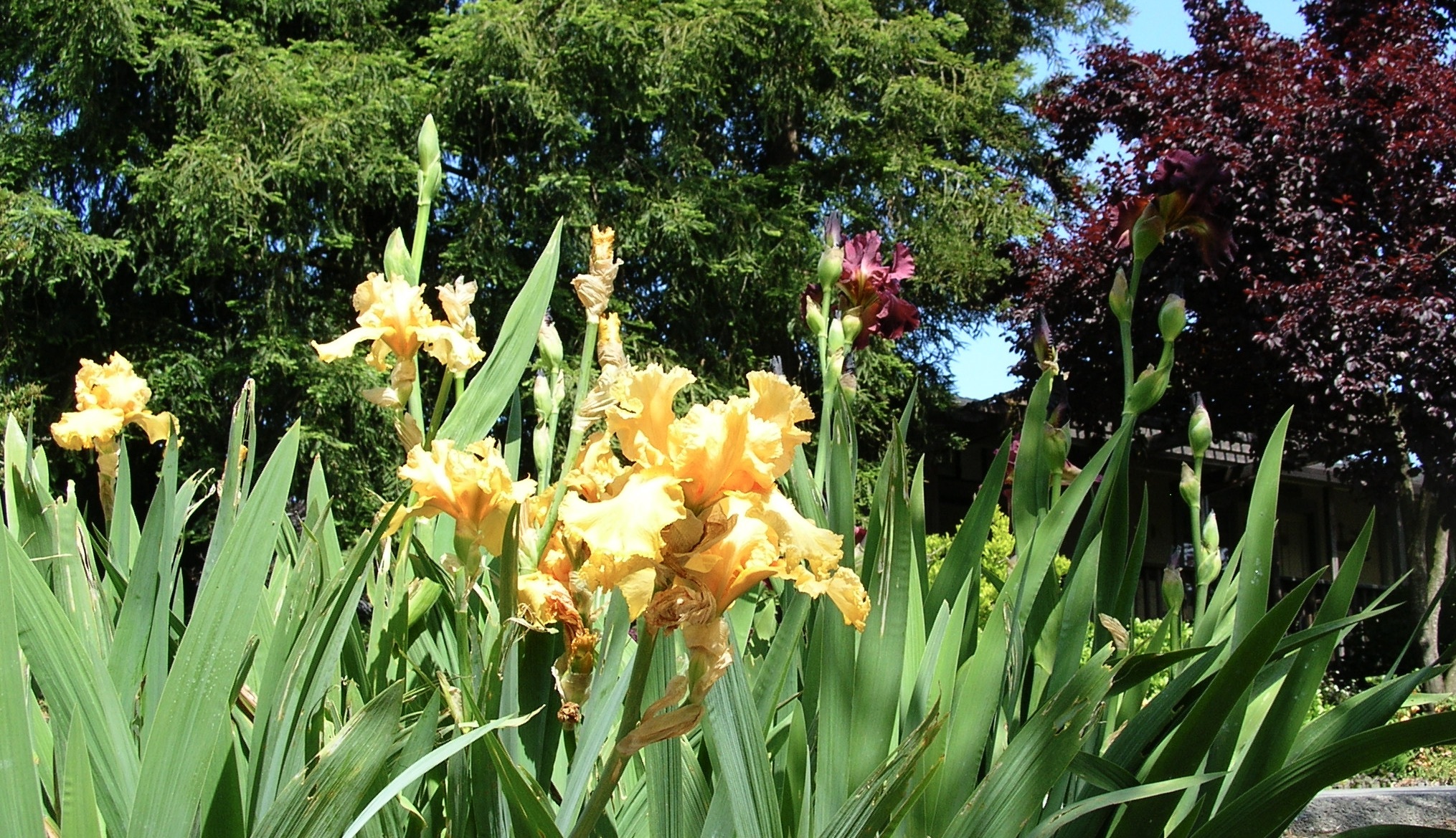
Iris make a splash in spring
In the first place, here I was gardening in Sunset Zone 15 (USDA 9b), which barely ever sees a hard freeze, with beds replete with perennials that were dormant for nearly half the year! Winter, not only a mild season in my Sonoma County, California garden but also a particularly lovely one, abounded with shapeless hulks of dormant--nay, dead--foliage. The perennials, when in flower, were undeniably pretty, but the effort was great. They required heavy shearing in late winter, were slow to get going in spring, and no sooner had they shown themselves to best advantage in May and June than they crisped in the mid-summer heat and began the slow descent into winter, only to start the entire cycle again.
Too, the perennials lacked structure. They were mostly round and grew into each other with a resulting lack of definition that began to irritate me. These 'blobs of color' lacked sophistication and, like people with lovely complexions but mediocre bone structure, were certainly pretty but no one would call them beautiful. The lack of structure was particularly noticeable in the garden's off-season.
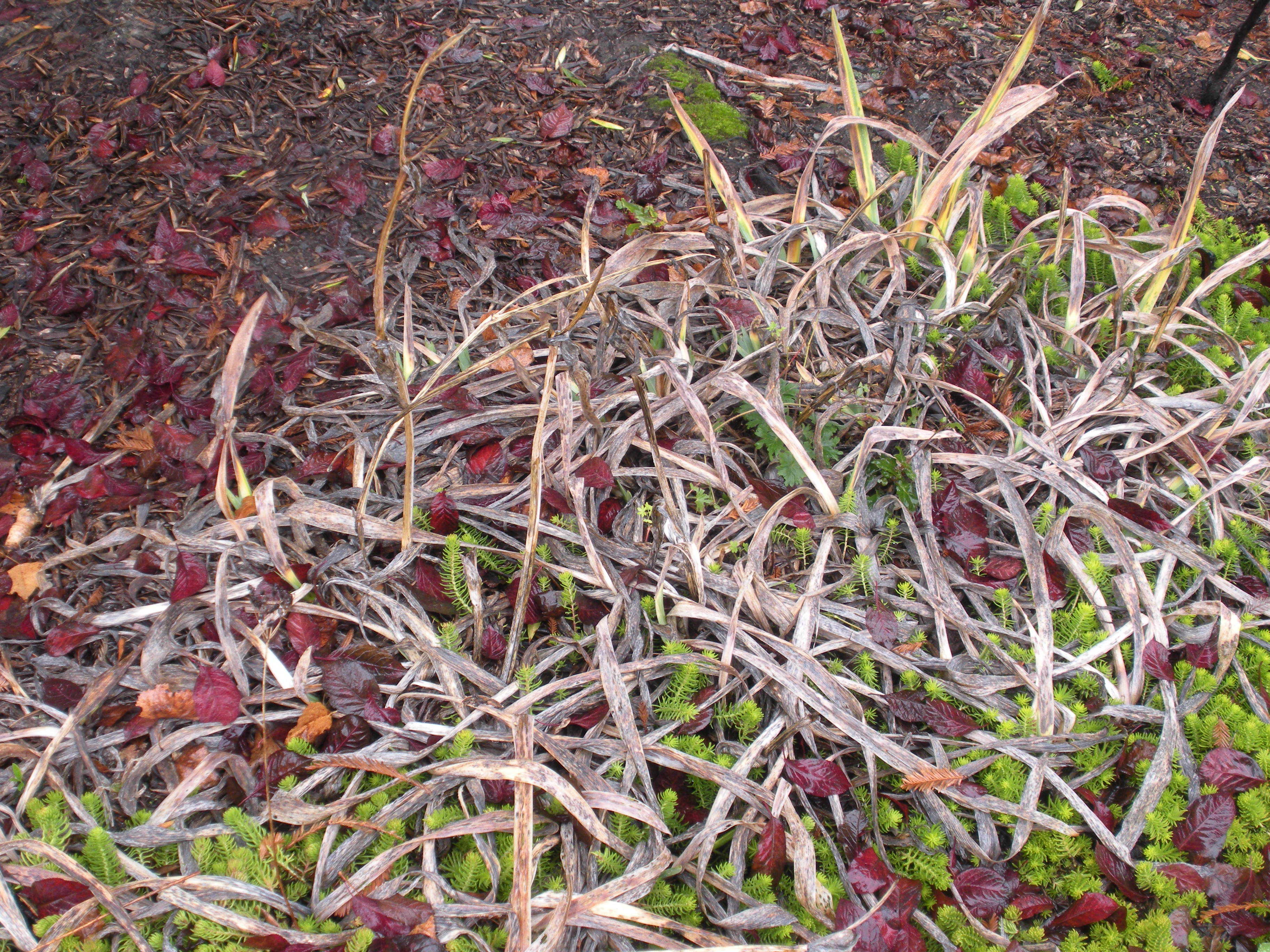
The iris garden in winter. Yuk.
While this theme was swelling in my mind, a counterpoint emerged: the maintenance was wearing me out, especially since the plants were dictating the schedule, not I. If I happened to miss the late-winter shearing, the plants would push new growth through last year's dead stems and the resulting mess would require either sacrificing a goodly number of fresh shoots and setting the plants back, or living with the tangled web of new foliage snarled in the detritus underneath. To get the best performance from most of the perennials during the growing season I had to ''refresh" them (i.e. hack the blazes out of them) every six to eight weeks. My vacation schedule was determined by the garden chores, most of which I derived less and less pleasure from.
The Real Thing
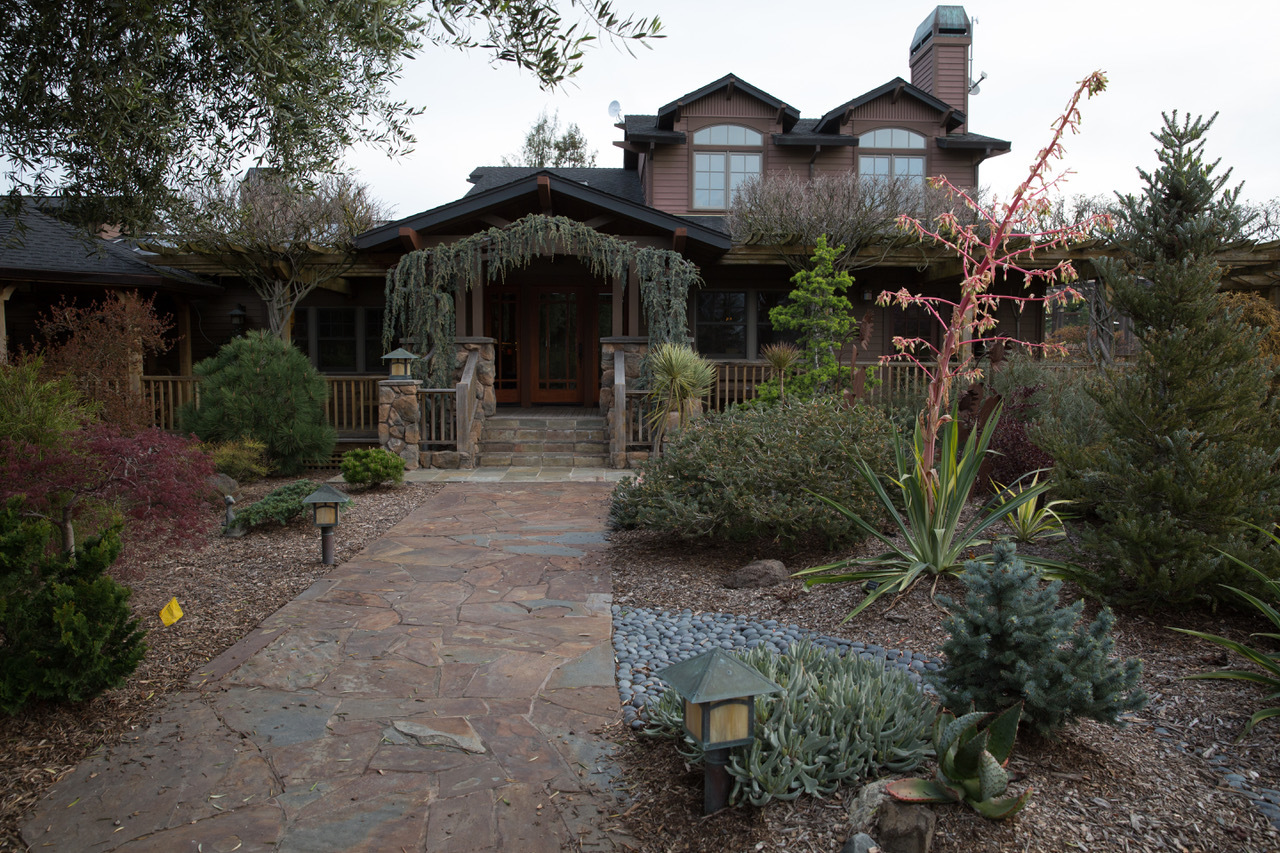
A pair of Cedrus atlantica 'Glauca Pendula' flank the front door
Do I sound like someone ripe for a new garden romance? Little did I know that Mr. Right was on his way! He arrived in the form of Adrian Bloom, not in the flesh, but by way of his book, Gardening with Conifers, which a friend gave me for Christmas. Adrian turned out to be the man of my dreams. In fact, he gave me a new dream entirely: to have a landscape as rich in color as a perennial garden, but with year-round interest and much more structure and texture than the perennials could provide. This was not just a new romance, but a mature, enduring love affair that resonated deeply with me after my infatuations with pretty flowers! It was also not lost on me that the woody plants would not require the constant attention demanded by the coquettish perennials.
We all look back fondly to our 'first times' in life, and my first conifer was a twofer: a pair of Cedrus atlantica 'Glauca Pendula' to flank the front door. Almost immediately upon reading Bloom's book, and with no regrets whatsoever, I hacked back and yanked out a couple of messy, ungainly Miscanthus sinensis 'Gracillimus' and replaced them with the sophisticated, seductive curves of the cedars. They looked like they were designed for the site and their cool, powder-blue needles and smooth, undulated trunks invited me to touch them each time I passed. I felt myself interacting with them in ways that I had never experienced with a flowering plant; their structure gave them a prominence and a complexity that had me immediately anthropomorphizing and imbuing them with quasi-human attributes. I stopped short of naming them, but don't think that I wasn't tempted!
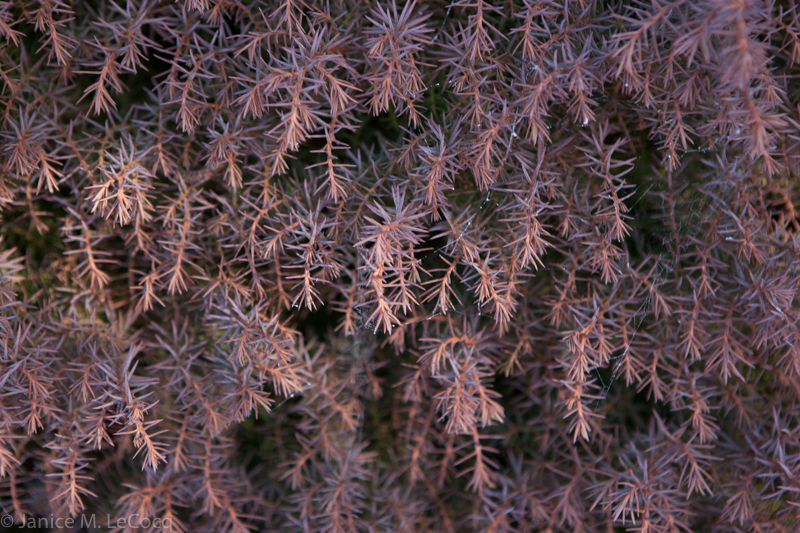
Cryptomeria japonica 'Mushroom' foliage in winter
I never looked back. My next purchase was a Cryptomeria japonica 'Mushroom', in full winter lilac-tinted bronze. I combed the conifer books, the catalogs from specialty conifer growers like Iseli and Buchholz, where I couldn't shop but could certainly fantasize, and making wish lists which grew longer and longer. Fortunately, Sonoma County is home to some fabulous nurseries, both retail and wholesale. There are a few that specialize in conifers and I began to haunt them, pumping owners and staff for their favorites and finding out when new shipments were due so that I could meet the truck and not miss anything.
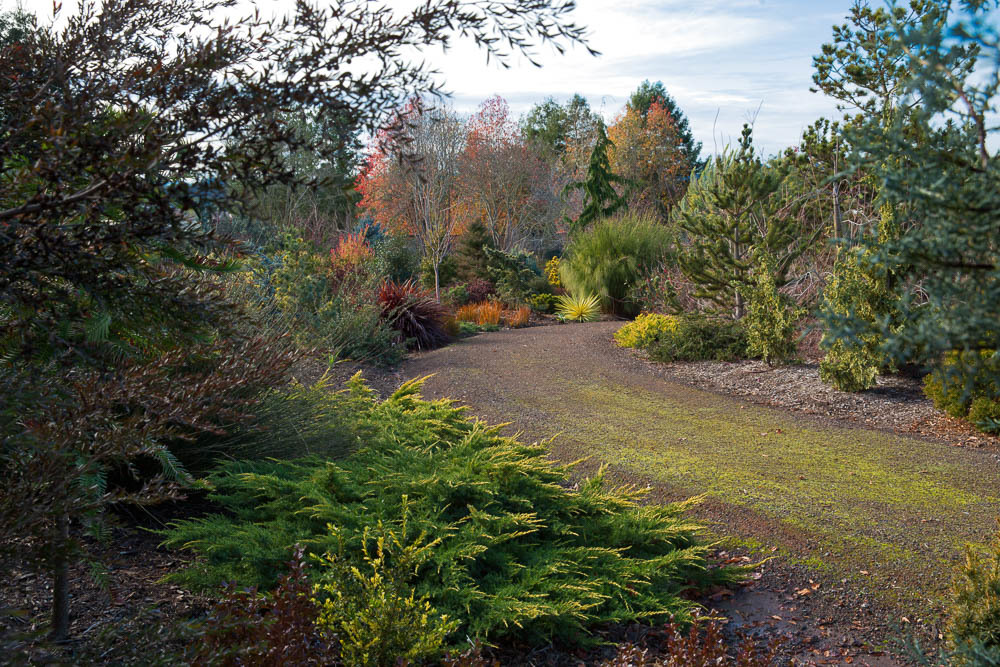
A Glorious Garden of Conifers
The garden in mid-winter: Juniperus x 'Daub's Frosted', Cupressus nootkatensis 'Green Arrow', Pinus nigra 'Oregon Green'
I then graduated to special-ordering specific cultivars and doing my research well ahead of the ACS auctions so that I could make the most of my bidding. I have learned to pick and choose among the species and the cultivars and understand which selection is best for a particular spot. I have learned, too, that not every plant can be a 'diva'; the garden needs a robust chorus to back up the soloists. I've also learned that conifers come in surprising forms and colors. My garden has graduated from an assortment of flowering perennials to a collection of specimen conifers and other rare and select woody plants. It now has four seasons of interest instead of two and has all of the structure that I felt was lacking in its prior incarnation, even on foggy days or in low light. I no longer spend the month of March chopping back perennials; I now spend it admiring the new foliage and emerging cones of the conifers.
I marvel that I went so long before I found true garden love. Now, as I wander the paths of my garden in all seasons, I find satisfaction and sustenance from the incredible variety of conifers which dominate the landscape. Their breadth is astonishing: from the grandeur of the sculpted Pinus nigra 'Compacta' to the delicacy of the Chamaecyparis lawsoniana 'Barry's Silver'; from the rugged stoutness of Pinus jeffreyi 'Joppi' to the elegance of Cupressus cashmeriana; from the dusty turquoise of Cedrus deodara 'Prostrate Beauty' to the brilliant gold of Chamaecyparis lawsoniana 'Golden Showers'; from the whimsical Sequoiadendron giganteum 'Pendulum' to the wistful Pinus wallichiana 'Zebrina' - oh, the list is endless!

Pollen cones on Pinus parviflora 'Cleary'
The seasonal highlights are noteworthy, as well. There is the spring new foliage on specimens such as Picea orientalis 'Aureospicata' and the male cones on Pinus parviflora 'Cleary', which are just as beautiful as flowers and never need deadheading. The summer green of many Taxus and Chamaecyparis cultivars keeps the garden temperature down when the mercury soars. Autumn's drama is enhanced by the golden needles of the Larix and the blues of the Picea pungens, which showcase the fiery deciduous foliage. Finally, the bronzy winter cloaks of the Cryptomeria and Microbiota smolder with highlights of lavender and burnt umber.
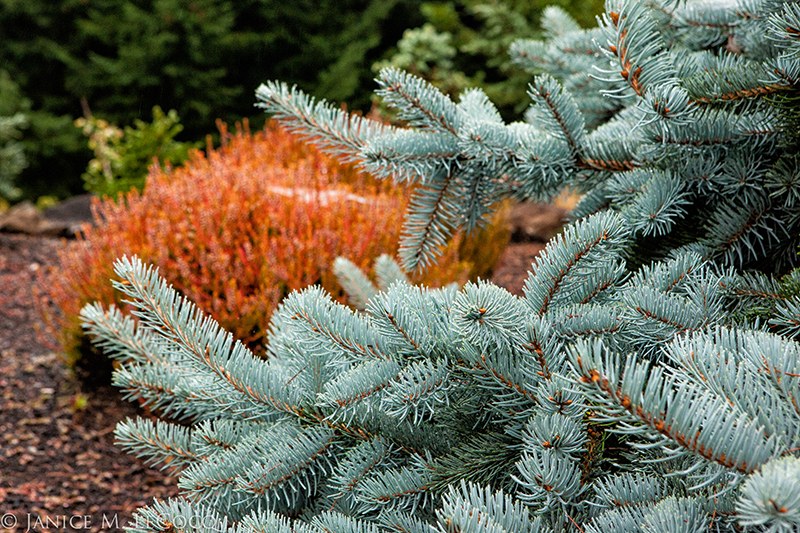
Nothing brings out the fall colors like the blue needles of Picea pungens cultivars.
May I share the final, wonderful aspect of my new-found garden love? When you begin a new love affair, don't you always wait with trepidation to see if your friends will approve? I'm delighted to report that conifers play well with others! In my garden they romp with an amazing variety of Acer palmatum, Southern hemisphere natives such as Leptospermum, Leucodendron and Condropetalum, structural succulents such as Agave, a host of California natives, including Arbutus and Arctostaphylos, and an array of deciduous shrubs such as Fothergilla, Cornus and Spirea.
It took me a while, but I finally found the love of my garden life. Like all true love, I expect it to grow stronger and sweeter with age. Are you seeking garden love? Tell us where you've found it! We'd love to hear your stories and see your photos.
Photographs by Janice M. LeCocq. The second edition of 'Gardening with Conifers' by Adrian Bloom, photographs by Adrian and Richard Bloom, was published in 2017.
This post has not been tagged.
Permalink
|
|
|
Posted By Admin,
Thursday, June 8, 2023
|
By Ronald Elardo
April 13, 2020
ACS members share their discoveries of fungal pathogens in conifers.
home of Ron Elardo. Photograph by Ron Elardo
signs of its disease. Photograph by Leah Alcyon
the home of Leah Alcyon. Photograph by Leah Alcyon
Conifer-Attacking Fungus: Setomelanomma rostrata
In 2008, Michigan State Extension researcher, Dennis Fulbright,
also confirmed the existence of the Setomelanomma fungus. Thus, Leah inadvertently uncovered a third conifer-attacking fungus. Kudos to Leah!
The researchers at NDSU do not say very much about the fungus in their report, other
than to ID it. They do, however, mention that fungicides on the market can treat Rhizophaera but not Stigmina, and vice versa, but nothing about treating Setomelanomma.
On the other hand, Fulbright lists 5 ways
to minimize Setomelanomma, Rhizosphaera, and Stigmina:
- Choose trees appropriate for the site
- Buy high-quality planting stock
- Plant with proper spacing
- Do not mulch up to the trunk and
- Water during dry periods. I planned to be more exact: site the conifer in a spot that drains well, so that the plant does not sit in water.
Phomopsis Tip Blight Fungus
The fourth species of fungus attacking conifers is Phomopsis juniperovora (Phomopsis tip blight), identified in 1917! Phomopsis causes the new growth on conifers, both on seedlings and mature specimens, to turn brown and wilt.
The infection begins with the germination of asexual conidia (asexual, non-motile
spores of a fungus, also called mitospores), borne from pycnidia (asexual fruiting bodies produced by mitosporic fungi). The mycelia, the vegetative parts of a fungus, move inward down the branch and eventually into the main stem.
In order
to check the spread of this fungus, the blighted tips should be removed and destroyed. You must also sterilize any pruning tools to avoid the spread of the pathogen (a very good IPM practice).
Researchers recommend choosing resistant varieties
and spraying new growth with fungicide until the plant(s) has (have) matured.

Stigmina on the needle of Rocky
Mountain bristlecone pine (Pinus aristata) at the
home of Leah Alcyon. Photograph by Leah Alcyon
Seeking Fungus-Resistant Conifers
I have never seen a plant tag labeling a plant as “Phomopsis-resistant." It
is possible that, since 1917, certain conifers might have become resistant, or been even bred as such, but my now 15- feet tall Pseudotsuga menziesii (Douglas-fir), planted
in 2003 as a 5-footer, did not come as a Phomopsis-resistant plant.
All of the tips of this Douglas-fir are limp and browning for the third year running. Unless I scale a very tall ladder—or rent a cherry picker—to remove the blighted tips,
neither of which I will do, I am going to have to take that tree down.
Once the tree is felled, I will cut off the infected tips and cut up all the branches, seal the tips and pieces in paper garden waste bags, and transfer everything to
my waste collector for disposal. The trunk of the tree will be cut up and burned.
My advice: caveat emptor (buyer beware)! Read the plant tag and hope that the plant you have chosen is Phomopsis-resistant, or resistant to any kind of fungus,
for that matter!
Fungal Attacks: Conifers to Avoid
Phomopsis juniperovora is known to attack:
Stressed trees are more likely to fall victim to opportunistic pathogens or insects. Whatever the stress-producing agent, significant numbers of conifer species are succumbing to fungi. Every living organism on
Earth is programmed to die, but the acceleration of the demise of some conifers comes directly from fungal infection.

Setomelanomma fungus
on the bark of Scots pine (Pinus sylvestris). Photograph by Leah Alcyon
In an NBC News report by Jacelyn Jeffrey Wilensky, climate change, insect invasion, tree death, and deforestation are noted to increase the release of CO2. As a result, the
amount of that greenhouse gas balloons and causes an ever-increasing hostile environment to life.
Add to that what Jill Wegryzn (University of Connecticut Stress Genetics professor) writes about the weakening of the immune systems of trees
through drought and weather extremes, and certain of our conifers face serious challenges.
A former colleague of mine at Adrian College, Dr. Craig Weatherby (Emeritus Professor of Biology and Environmental Studies), has been studying box
turtles (Terrapene sp.) all his professional life.
I once asked him why he dedicated his life to those animals. He immediately replied: “Because the way the turtles go, humans will go.” Box turtles are now an endangered species.
Click here to read more about other fungal diseases like oak wilt, cedar apple rust and white pine blister rust.
This post has not been tagged.
Permalink
|
|
|
Posted By Admin,
Thursday, June 8, 2023
|
By Jeff Harvey
July 10, 2017
Text and Photos (except as noted) by Jeff and Jennifer Harvey

Maud with ‘Maud’
This year, the Southeast Region initiates the Southeast Signature Plant Series, an ongoing project of the Southeast Region to develop new cultivars of conifers that are suited to SE gardens. Selections will be seedlings, witch’s brooms, or sports that have not been previously introduced or shared. They will be miniatures or dwarf varieties, whenever possible. Each new cultivar will be named in honor of a person who has been important in the history of the ACS in the SE region. The first Southeast signature plant is Thuja occidentalis ’Maud’, named in honor of Maud Henne.
Maud Henne and her late husband Reinhard started their conifer collection around 1985 and became members of the ACS in 1986. Maud was ACS executive secretary while Jordan Jack was ACS president, and between the two of them, they created the Southeast Region of the ACS. Our first president, in 1998, was Mac Stiff.
Maud has been one of the driving forces of the Southeast Region for many years. She has held the office of Regional President and was the newsletter editor until 2015. She also organized several conifer events, including the regional meeting. I believe she started the Outstanding Service Award for the Southeast Region when she gave Jordan Jack the award during one of the first regional meetings Jennifer and I were able to attend.

Maud Henne with Jordan Jack and his Outstanding Service award. Photo by Flo Chaffin.
Paperwork for Thuja occidentalis ’Maud’ has been submitted, and we expect it to be approved, shortly. It is one of Dr. Clark West’s 3rd generation seedlings from Thuja occidentalis ’Filiformis’, which we were able to obtain with the help of Chris Deager. Although the parent plant is a threadleaf form, ‘Maud’ has fan-shaped leaves and is a slower grower. The seedling is currently 11 years old and has a slightly columnar habit with growth rate around 2 to 3 inches a year. Several of us have been able to take cuttings and we hope to be able to share this wonderful plant named after a great lady with the group for many years to come.
Excerpt from the September 2016 Southeastern Conifer Quarterly. Gain access to archives of past newsletters and the National Conifer Quarterly by becoming a member of the American Conifer Society.
This post has not been tagged.
Permalink
|
|
|
Posted By Admin,
Thursday, June 8, 2023
|
By Elmer Dustman
November 7, 2019
Find out how pruning creates consistent texture and appearance in conifers, while encouraging healthier growth in the long run.
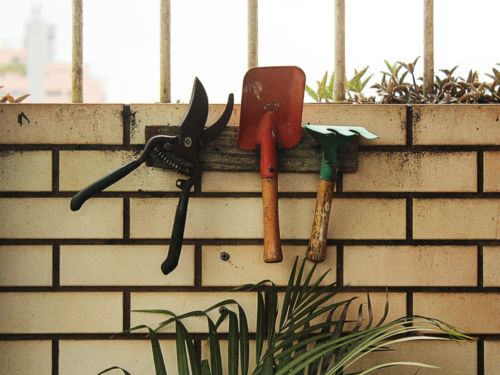
There is a different concept of pruning, called Aesthetic Pruning. My Aesthetic Pruning definition is: controlling plant growth in a way which results in plants which look convincingly natural and untouched by human hands.
The gardener must have two arsenals of knowledge: the growth habit of the plant and the use of proper pruning tools. The reference I use is Edward Gilman’s 2012 book, An Illustrated Guide to Pruning (Third Edition), Chapters 5 and 18, Pruning Cuts, and in Pruning Landscape Trees and Shrubs, published by Delmar Cengage Learning.
There are three basic pruning terms that I will discuss:
Reduction Cuts
Removal Cuts
Heading Cuts
These are two additional cuts to be used:
Tipping
Shearing
Defining Pruning Terms
Reduction Cuts are used to “reduce” or shorten the length of a branch by pruning it back to a branch junction which is large enough to assume apical dominance. This branch varies by species, but should be 1/3 to 1/2 the diameter of the cut stem. To make the cut, bisect the angle between the branch bark ridge and an imaginary line perpendicular to the branch to be removed. This cut is used to maintain the size and shape of the tree or shrub.
Removal Cuts are made back to the collar, or to the point of attachment. This cut is often used to thin-out the plant’s foliage. This encourages light and air circulation resulting in a healthier specimen. Removal cuts can be used to lighten the weight of branches and removal of dead wood.
Heading Cuts shorten a branch to a stub or to a bud or a lateral branch not large enough to assume the terminal role. This can cause the tree to sprout excessively from the cut.
Other Pruning Techniques in Conifers: Tipping
Tipping/pinching is a technique of removing the last few buds, leaves, or sprouts from the end of a stem. It is performed for a number of reasons. It can slow down a tree’s rapid growth; it can redirect a tree’s energy into smaller, more desirable shoots or buds, and it can give a consistent texture and appearance to the newly pruned plant.
Tipping is easiest during the soft-lush-growth stage by using the fingers. For pines, breaking the new growth candles to the desired length before hardening controls the total yearly growth. The use of hand shears for removals must be done on new growth after it has hardened, which can cause browning of foliage and needles.
Other Pruning Techniques in Conifers: Shearing
The overuse and misuse of sheared shrubbery is one of the most common forms of landscape mismanagement. Because shearing is non-selective heading, you will stimulate bushy growth. You create a twiggy outer shell on sheared plants. This layer of twigs shades out the interior, which then becomes leafless and full of dead leaves and dead wood.
Meanwhile the outer shell becomes thicker and larger farther out to retain its greenery. The dense outer shell makes size reduction difficult because cutting back too far exposes the ugly dead zone. Although most plants will bud back and eventually reform, there are some species like junipers which won’t regenerate.
Power hedge shears do tremendous damage with [lots of] broken and crushed stem tips, torn bark and chewed leaves. This leads to wound responses and both bacterial and fungal invasions.
Alternatives to Shearing in Conifers
The only plants I shear are Boxwood and Privet, using manual hedge shears held in the horizontal position. This is because they have small leaves and are formal in appearance. The highest quality “shearing” isn’t even shearing at all. Instead it consists of the carefully performed “snip-by-snip” technique, which leaves no heading cuts at all; the manual head shears are held in an vertical or right angle position for “targeted” cuts on junipers, barberries, Spiraea, hemlocks and many more species with follow up use of hand shears for fine pruning removals.
Targeting cuts to inner branchlets opens up the plant to let in more light and air circulation, allows new growth to emerge from buds or side branches, and controls plant size. I prefer that certain shrubs be pruned in a semi-spherical and not a ball-like shape.
The preferred ratio of height to width is 1 to 3. This allows the entire bush to have new foliage or flowers and appear ground-hugging. Many shrubs with sheared tops have exposed sides which have little new foliage and the shape is of little interest.
Things to Consider Before Pruning
What does the tree or shrub look like in nature in its most mature form?
Find examples in the landscape as you drive down the street and in books and garden magazines!
Check branch forms: hanging or upright shapes?
Observe ratio of height to width to inform your pruning goals!
Where are the empty spaces between branches and note branching pattern?
Information selected from The Journal of Japanese Gardening, published by Douglas M. Roth, Plant Amnesty Newsletter, www.plantamesty.org.
Photograph by David Rangel.
This post has not been tagged.
Permalink
|
|
|
Posted By Admin,
Thursday, June 8, 2023
|
By Christy Docauer
November 17, 2022
"The return of the investment is its effect on the quality of life. Conifers not only add to the beauty of a garden, providing an intrinsic value to a home and its garden, but they also offer a reason to become part of an extraordinary world. That world is one populated with people who share a love for these same plants."
In Bob Fincham's piece titled, "What is the Hobby in Collecting Conifers: An Obsession or an Investment?" he shares why his 46-year-old obsession is one that needs no treatment. Read more from the Summer 2022 ConiferQuarterly HERE.

This post has not been tagged.
Permalink
|
|
|
Posted By Admin,
Thursday, June 8, 2023
|
What's Wrong with my Blue Spruce?
By Web Editor
January 29, 2021

Blue spruces are virtually unmatched in their 'blueness' This photo features two cultivars of Picea pungens
Why are Blue Spruces so Popular?
Blue is generally a much-sought-after color in the garden, as is attested to by the abundance of flowers that have 'blue' in their names, despite clearly being shades of purple, lavender or mauve. So if so many flowers that are purported to be blue are not, how do you get real blue in your garden? Blue conifers, of course! Because in the world of conifers, when we say blue, we mean blue! The photo above contains two cultivars of Colorado spruce, also referred to as blue spruce, one of the bluest conifers out there. In the background, Picea pungens 'Fat Albert' draws the eye and provides soft, elegant contrast to the green foliage around it. In front, the cultivar 'Lucretia', has clear, powder-blue needles and a more random growth habit. Blue spruces have been popular primarily because of their color, although their stately, conical or columnar shape is attractive. However, blue spruce can often present problems when used in the home landscape.

Blue spruce at head of Colorado River, at Rocky Mountain National Park. Photo by Kristen Bobo
Colorado (or Blue) Spruce in Nature
Colorado spruce, also referred to as blue spruce, is botanically styled Picea pungens. Picea is the genus name for spruce, and pungens, its species name, means 'sharp' or 'spiny' in Latin, which refers to the spikiness of the needles. (Read more about botanical terminology.)These trees, as their common name suggests, are native to the central and southern Rocky Mountains, a semi-arid steppe climate, where they occur in varying shades of greens and blues. The blue spruces that we know from home landscapes were selected for their blueness (more about that later). The blue coloring is due to a waxy substance on the leaf surface that protects the tree from desiccation and harmful UV light.The more wax, the bluer the needles. This waxy coating can be harmed by repeated touching (there is even anecdotal evidence that in very windy sites the trees lose their blueness), excessive rain or overhead irrigation, or by some pesticides and dormant oil sprays. Any of this disturbance to the wax can turn your blue tree to green. Blue spruce are extremely cold-hardy, able to withstand temperatures down to -40F/-35C, designated USDA zone 3.
The trees in nature can reach impressive heights; it is not uncommon to find individuals that are over 100' tall, with trunks 5' or so in diameter. It is a relatively slow-growing tree, as wild trees go, but it is long-lived (many reach 600-800 years). Picea pungens does best in cool climates with regular, short bursts of summer rainfall, conditions that are difficult to duplicate outside its native, mountainous, range. In habitat, it is more often than not found growing near streams, where the soil moisture is higher than the surrounding area. One source suggests that blue spruce require the same amount of water as Kentucky bluegrass!
Blue spruce is probably the most widely known, widely planted blue conifer in the United States. It is also likely responsible for most dislike of conifers! Why? Because species Colorado spruce trees were heavily planted in new residential communities in the early to mid-20th Century, and most, if not all, were planted with no regard for their ultimate size or whether they were climate-appropriate. While it may be an urban legend, it is said that a blue spruce in the 1930s and 1940s was a status symbol, widely proclaiming that the homeowner had 'arrived'! Even a 'slow growing' tree can outgrow its garden location!

It's a question of scale...
This Colorado spruce was probably planted about the same time that the house was built. It was likely an adorable, size-appropriate landscape addition at the time. Seventy five years later, the house is still the same size, but the tree now towers over it, shading the interior all year long. The two cultivars (short for 'cultivated variety', a term used for plants that were selected by horticulturalists and growers for garden-worthy characteristics) shown in the first photo, grow MUCH more slowly and were selected for the intense blueness of their needles.
Homeowners don't just dislike blue spruces because they get too big, they dislike them because in many places that they were planted, especially the East coast and the Midwest, they have eventually performed poorly, succumbing to needle cast diseases and canker. Despite the widespread planting of blue spruce, they usually do not perform well over time in climates with humid summers, warm nights or inadequate rainfall or irrigation. Yes, you read that right. If you live in the Northeastern, Southeastern, Midwestern or Northwestern parts of the United States, despite the fact that blue spruce are ubiquitous, most eventually fall prey to disease and languish. Blue spruce is also commonly planted in northern Europe, where it suffers similar problems to those it experiences in the U.S.
Blue spruce with needle cast disease. Photo by University of New Mexico Extension
Blue Spruce Diseases
By far the most common complaint of cultivated blue spruces is needle cast disease, mostly that caused by the fungus Rhizospaera kalkhoffii. It infects young needles and overwinters on living or recently killed foliage. During the growing season, the spores spread to other branches, or other trees, by splashing water. Warm temperatures (high 70's) exacerbate the needle infection. The disease generally presents as it does in the above photo, with the older needles dropping off first. There are other pathogens that can cause needles to die and drop off, but Rhizospaera is the most common, followed by Stigmina/Mycosphaerella.
Tip blights can also be a problem. Whereas needle cast can affect the older needles, tip blights are fungal diseases that cause dieback only to new growth. These kinds of blights are most common on pines but can affect spruces as well.
Finally, canker diseases are caused by yet another type of fungus that attacks the branches or the trunk of the tree. Cytospora is the most common canker pathogen.
These three fungal diseases were, for decades, the most common afflictions of blue spruce in the home landscape, but Michigan State University has identified two other fungal pathogens, Diplodia and Phomopsis, which are deemed secondary pathogens so the extent of their contribution to spruce death is unclear.
There are insects, too, that can cause damage to blue spruce, but it is the fungal pathogens that typically contribute to the poor cultural results observed on out-of-range species trees.
Unfortunately, despite the availability of pathogen-specific pesticides and oil sprays, once a tree is infected with a fungal disease it is very difficult to halt the decline, much less reverse it, even with dutiful spraying. Old, large trees planted in commercial spaces or in home gardens that were 'inherited' by new owners are generally left to make it on their own, with little supplemental care. This is one of the reasons that there are so many large blue spruce in decline in many parts of the Northeast, Midwest, Midatlantic and Southeast.
How to Grow Blue Spruce Successfully
To recap, blue spruce are only native to the mountain west, they generally occur at higher elevations, they prefer a cool climate with wet summers and are extremely susceptible to fungal diseases in cultivation outside of their native range. So what's a blue spruce fancier to do? And while there are certainly copious examples of poorly performing (or dead) blue spruces all over the United States (and Europe), there is also copious anecdotal evidence of spectacular successes. What is not clear is whether the successes are isolated to a few non-Rocky Mountain areas where the climate mimics that of the native range, whether they are just too young to have suffered the inevitable diseases, whether the particular cultivar in question is somewhat or completely disease-resistant, or whether the particular site or cultural practices worked in favor of the tree's health. Taking these one by one:
- Location. Obviously if you are in the native range, you should be able to grow Picea pungens successfully. Areas bordering on the native range are likely also to have climatic conditions conducive to success with this tree. The summer-dry Mediterranean climate of coastal California and Oregon also seems to produce long-lived, healthy landscape trees. If you are outside of these areas, careful cultural practices will improve your chances of success. There are ample examples of healthy, decades-old blue spruce in the Midwest and the Northeast and even in parts of the Southeast.
- Age. Unless you are the steward of a family estate or the curator of a public garden or other public space, it is unrealistic to think in terms of centuries when planning your garden. You have no control over what happens after you move or die; the next owner may chop the trees down and put in a swimming pool. So for most of us, it is logical to think in terms of a few decades at most. Thus, even if disease is going to get the tree in the end, but you can enjoy a few decades with it, that may not be a good enough reason to avoid a blue spruce. Dennis Groh notes that from what he has read, "the species spruce are disease resistant when they are young and growing vigorously. It seems that at about 25 years something happens and the spruce become highly susceptible. One article speculated it could something to do with the tree's inability to move adequate water to all parts of the tree and a resulting inability to then defend against disease attack. Another speculated the tree at some point exhausts all available elements in its rather limited root zone and requires supplemental fertilization to support its rapid upward growth and maintain its defense against disease. I have seen the root system on 70 foot spruce and it is much smaller than I would have expected based on deciduous trees."
- Disease-resistant cultivars. This is the most difficult factor to assess. There is no hard evidence that Picea pungens cultivars in general, or any specific cultivars, are more resistant to disease than the species trees. While most of the examples of success are, indeed, cultivars, that could well be due to the fact that most conifer enthusiasts plant cultivars, not species trees; that the cultivars are newer to the market, thus younger and not yet affected with disease; or that more care has been taken with the cultivars as they are generally thought to be more 'special' and are certainly more expensive than the species. (What's the difference between a species and a cultivar?) It should go without saying that choosing a cultivar with a slower growth rate than the species is also a good idea, unless you are landscaping vast parkland.
- Cultural practices. This is key. If you have decided, despite the issues, to plant a blue spruce, your best chance of success is to plant and care for it properly.

Picea pungens 'Jan Byczkowski' in Northern California's Mediterranean zone 9b
Evaluate your Climate for Blue Spruce Success
- In the Mountain West or near it, you can grow blue spruce successfully.
- In Mediterranean climates from Central California through Oregon, blue spruce tends to do well, although it may require supplemental irrigation. The cool summer nights and dry summer air are similar to those in the tree's native range. Established trees seem to be more drought-tolerant.
- In the upper Pacific Northwest, the weather tends to be too wet and fungal pathogens are too numerous. Another choice would likely be better to ensure long term success. Blue spruce is extensively produced in Oregon, where growers focus on using disease-resistant stock, avoiding overhead watering and avoiding pruning when the foliage is wet.
- In the upper Midwest and Northeast, blue spruce have been extensively planted and there are almost as many success stories as there are those of decline and death. This is where cultural practices may make a significant difference. Longevity (or lack thereof...), cultivar selection and luck may also have had a hand in the results! It is worth noting that one of the most popular blue spruce cultivars, 'St Mary' (also called 'St. Mary's Broom') not only has anecdotal evidence of success in the Northeast, but was actually found on a tree growing in Morristown, NJ.
- In the lower Midwest, according to Edward Gilman, professor emeritus of horticulture at the University of Florida, blue spruce 'is not for Dallas and south Texas, but Lubbock and into Oklahoma is suitable'.
- In most of the American Southeast, you will likely want to select a different conifer than a blue spruce. Tom Cox, who, with John Ruter, wrote 'Landscaping with Conifers and Ginkgo for the Southeast', firmly believes that summer nighttime temperatures regularly have to dip below 70 degrees F by 10:00 pm in order for blue spruce to be successful. In addition, he suggests that the heavy summer rainfall in much of the Southeast tends to dissolve the waxy coating that gives the blue spruce its blueness, making them a dull green instead of an arresting blue. In fact, he says that if he were to revise the book, he would not recommend Picea pungens for any parts of the Southeast, with the exception of higher elevations, such as Asheville, NC. Those that do survive, he notes, are not particularly attractive.
- In the few parts of the US that are tropical, you will also have to find your garden blue elsewhere, but there are conifers for you, too!

Picea pungens 'The Three Deuces' in Dennis Groh's Michigan garden
Which Blue Spruce Should I Plant?
For long-term satisfaction with your blue spruce, select a cultivar, not a species tree. A species, or wild, tree will simply be labeled 'Picea pungens'. Cultivars, selected for particularly attractive features or growth habits, always have a 'third' name on the label, e.g. Picea pungens 'Pendula'. The cultivar name may reveal something about the tree's growth pattern, as well as identify it as a selection. 'Pendula' is a weeping form, whereas 'Fat Albert', not surprisingly, has a wide shape. 'Glauca Procumbens' creeps along the ground. Cultivars will almost always grow significantly more slowly than their wild cousins and do not reach such massive proportions.
It is the slower growth rate and wide range of growth habits that make cultivars better choices than species trees for home landscapes. That photo of the species tree towering over the house would look very different if, instead, the homeowner or builder had planted a Picea pungens 'Hoopsii', which grows at about half the rate of the species. (Bonus: 'Hoopsii' is viewed as one of the very bluest by many conifer enthusiasts!)
You want to begin by evaluating the spot where you want to plant your Colorado spruce. How much space does it afford? Cultivars of this tree range from very small and slow-growing to those that grow at about half the rate of the wild trees. Some are intensely apically dominant with a pronounced excurrent form (A tree with a straight trunk that goes from the ground all the way to the tip; classic 'Christmas tree' shape.) Others scramble along the ground, weep, or are sedate bun-shapes. So, the first question to ask yourself is, where do I want my blue and what shape and general size should it be?
Note that the more irregular forms of blue spruce (and any conifer) are easier to keep pruned to a desirable size, as they do not present the problem of having to cut off the top and destroying the conical shape. And many cultivars, such as the one pictured above, form no leader at all and remain cushion or bun-shaped for their entire lives.
Finally, many cultivars have been selected for the intensity of their blue color. So if blue is your goal, review comments about the different cultivars and select accordingly.
Coming soon: The 10 Best Blue Spruce Cultivars
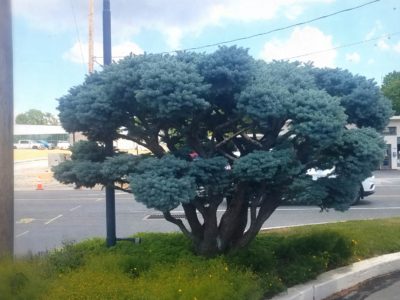
This Picea pungens 'Glauca Globosa' is thriving in Lancaster, PA. The pruning has helped with air circulation
How to Plant and Care for a Blue Spruce
As noted above, cultural practices are likely the most important controllable factor in whether or not your blue spruce not only survives, but flourishes. So let's assume that you are in a climate where needle cast diseases are prevalent, but you see local examples of attractive Colorado spruce and you want to try your luck. If you are in a climate where they are native, or a climate with similar attributes, it doesn't hurt to bear these practices in mind, either. Rhizosphaera needle cast is much more likely to be a problem with trees that are already in a stressed condition due to poor growing conditions.
- Blue spruce prefer acidic, moist, well-draining soils. If your soil is heavy and poorly draining, or is basic, plant in mounds of high quality soil with grit, pumice or pebbles added to increase drainage. DO NOT dig a hole and backfill with non-native soil. This creates a bathtub effect whereby the hole, with looser, lighter soil, simply fills with water during rain or irrigation.
- Plant your blue spruce so that the beginning of the root flare is evident. This is good practice for almost all woody plants, but with those that need good drainage it is particularly important.
- Blue spruce should always be planted in full sun.
- Maintain good air circulation around the plant. This means not overcrowding the plants in the bed or area. Remember to consider the tree's mature size when planning! If lower limbs are touching the ground, remove the entire limb or prune the underside or tips to lift the skirt so that it clears the ground.
- Pruning is fine; in fact, pruning to open the architecture and increase air flow is likely a positive. However, avoid shearing, as shearing produces dense, congested growth that holds water longer than the tree's natural foliage. There is anecdotal evidence that keeping the foliage as open as possible is helpful, which means getting inside and removing dead or unattractive branches and allowing the air and sunlight to reach as many needles as possible.
- Spread and maintain a layer of mulch covering the root zone of the tree (roughly to the edge of the branches) of several inches. This will keep the soil moister and cooler and reduce weed growth. Do not mulch up to the trunk; leave an inch or two so that the damp mulch is not piled up against the trunk.
- As noted above, blue spruce grow best in their native habitat when they are near streams and lakes. Make sure that your tree gets enough water, especially when young. Older trees may be more drought-resistant, but still need supplemental irrigation at times of scarce rainfall. Extended periods of drought can weaken the trees and make them more susceptible to pathogens.
- If you are in a summer dry climate, or in the mountain west, you can use overhead irrigation in summer, as the water evaporates quickly from the needles. If you are in most of the US or Europe, you should water using drip irrigation or a hose at the base of the tree. Avoid getting water on the needles, as the moisture promotes fungal growth and transmission.
- Fertilizing is not necessary when the tree is young, however, as Dennis Groh notes, "The key is to keep the tree well watered, fertilized, healthy and growing." So after its been in the ground for a few years, regular fertilizing is a good idea.
- If your tree does exhibit evidence of needle cast disease, you should seek confirmation of the specific pathogen before applying fungicide. Most county extension offices can review samples of infected foliage and provide a diagnosis. You can also search on line for examples of needle cast disease and compare with your plant. Different pathogens require different fungicides, so don't start spraying indiscriminately!

This Abies concolor 'Compacta' can give blue spruce a run for its blueness! Photo by Dennis Groh
What to Plant instead of a Blue Spruce?
While blue spruce cultivars are the most widely-planted blue conifers, that doesn't make them the only, or even the best, choices. Depending on where you live, you may have several attractive alternatives. Photos are in the gallery at the end of the article.
Blue Firs:
Abies concolor cultivars (USDA zone 4). Abies concolor, or white fir, Colorado white fir or Rocky Mountain white fir, is native to roughly the same area as Colorado spruce, but also to large sections of California, New Mexico and Arizona, even venturing into Baja California and Sonora. It is a fir, not a spruce, but its growth habits and appearance are not dissimilar to Picea pungens. As the photo above demonstrates, many of the cultivars are a striking, saturated blue. White fir has shown to be successful in the upper Midwest (the photo above is from a garden in Michigan) and Gilman recommends it for cultivation in the lower Midwest as well. It has been observed growing successfully in the Northeastern US as well. If you can grow it, this is likely one of your best choices, ,if not the best, for powder-blue foliage.
Abies koreana cultivars (USDA zone 5). Korean fir comes from high-elevation areas in Korea, that have temperate rainforest with high rainfall and cool, humid summers. Many cultivars, such as 'Blue Magic', have blue or blue-green needles, but they are not the light, powdery blue of blue spruce.
Abies lasiocarpa cultivars (USDA zone 5). This species is known as sub-alpine fir as well as a host of other common names and is native to Western Canada and the Pacific Northwest, extending into the Rocky Mountain states. Those that are styled Abies lasiocarpa var. arizonica have very glaucous, or blue, foliage. These cultivars have proved to be very successful in the upper Midwest.
Abies procera cultivars (USDA zone 5). This species, called noble fir, is native to the Cascade and Coast Ranges in CA, OR and WA. Some of the cultivars are very blue, and it has been grown successfully in Mediterranean CA and the upper Midwest. 'Glauca' is an elegant selection, 'Blaue Hexe' has powdery blue needles, and 'Glauca Prostrata' is a spreading form with silvery blue foliage.
Blue Cedars:
Cedrus atlantica cultivars (USDA zone 6). Cedrus, the genus of true cedars, is hardy only to USDA zone 6, so if you are in a colder zone you will have to give this one a pass. The cultivars 'Glauca Pendula' and 'Sapphire Nymph' are very blue, as is 'Blue Cascade' and 'Horstmann'. These cultivars vary enormously in their growth habits so check photos and descriptions before you make your selection. Tom Cox suggests Cedrus atlantica cultivars as good substitute for blue spruce in the Southeastern United States. Michael Larson, who gardens in central Pennsylvania, also uses Atlantic cedars in lieu of blue spruce. Dan Spear weighs in from Asheville, NC, with a thumbs up for 'Sapphire Nymph'. Some of these blues are very close in hue and tone to those of blue spruce.
Cedrus deodara cultivars (USDA zone 6) Deodar cedars have longer and softer needles than Atlantic cedars, and their blues tend to be deeper-hued. Try 'Prostrate Beauty' for a low, wide-growing plant, or 'Devinely Blue' for one that will eventually form a leader and grow into a tree. Robin Tower has a magnificent specimen of 'Devinely Blue' in her garden in North Carolina and Tom Cox also reports success further south in Georgia.
Blue Cypress and False Cypress:
Chamaecyparis lawsoniana cultivars (USDA zone 6). This species of false cypress is native to coastal Oregon. Some of the cultivars, notably 'Pelt's Blue' and 'Pembury Blue' are strikingly colored and as dramatic in the landscape as blue spruce. Note: Lawson's cypress is extremely susceptible to water mold infections caused by the soil-borne pathogen, Phytophthora . Most growers are now using disease-resistant rootstock, which eliminates the problem. ONLY buy C. lawsoniana if it is grafted onto DR rootstock.
Cupressus glabra cultivars (USDA zone 7). Cupressus glabra, or Arizona cypress, has several eye-catching icy blue cultivars. Arizona cypress is native to the American and Mexican Southwest. Some of the bluest cultivars are 'Carolina Sapphire', 'Blue Spire' and 'Blue Ice'. Most of these become fairly good-sized trees, and are not as formal and regular as blue spruce, but the colors are dramatic.
Blue Junipers:
Juniperus squamata cultivars (USDA zone 4). Probably the most dramatically blue is 'Blue Star', which is a low, mounding plant that does well in most of the US.This one benefits from more water than most junipers, with members in England and the Upper Midwest reporting that frequent summer irrigation is key to the plant thriving. 'Blue Carpet' is even more low-growing than 'Blue Star' but not as intensely blue.
Juniperus conferta cultivars (USDA zone 5). All J. conferta cultivars are tolerant of wind, shade adn salt spray, making them suitable for many spots where other plants cannot survive. 'Blue Pacific' has a low habit and soft, feathery foliage. Its needles are longer and softer than many other junipers and people who turn their nose up at junipers (more on that in a different article!) often really like this one. 'Blue Lagoon' is another nice choice.
Juniperus chinensis cultivars (USDA zone 4). These are quite cold-hardy and several cultivars have distinctly blue foliage. 'Angelica Blue' is a spreading selection, while 'Blue Point' is conical.
Juniperus scopulorum cultivars (USDA zone 3). This species, commonly called Rocky Mountain juniper, is about as cold-hardy as you will find among the blue conifers. 'Wichita Blue' is a conical selection that is rated 'intermediate growth rate'.
Juniperus horizontalis cultivars (USDA zone 4). This species is known as creeping juniper and some of the best low-growing blue conifers may be found here. 'Blue Chip' is a robust, very blue groundcover that makes a lovely blue skirt around a contrasting colored tree. 'Blue Rug' is another and 'Pancake' is probably the lowest growing juniper of them all!
Juniperus virginiana cultivars (USDA zone 4). Confusingly known as Eastern red cedar, this species has a large range, covering the southeastern US, the Midwest and venturing into Canada. Some cultivars, such as 'Royo' have a distinctly blue cast to their needles. Blue Flame is a particularly blue selection. For those of you in the Southeast, Tom Cox advises that 'Royo' is at the top of his list of blue conifers for both longevity and form.
Blue Pines
Pinus koraiensis cultivars (USDA zone 3). These are very cold-hardy choices with a variety of growth habits. 'Morris Blue' is upright, with silvery blue-green needles. 'Blue Ball' is a spherical dwarf, and 'Compacta Glauca' is a semi-dwarf conical shape. None of these cultivars will look much like blue spruce; they are darker colored and much greener blue. However, they do have a bluish cast and make attractive accents when planted with green-foliaged plants.
Pinus kwantungensis (USDA zone 9), another Asian pine, has a bluish cast and is an attractive choice if you live in a mild climate and have room for a species tree. It's much less common than most of the other species covered in this article, but deemed a winner in both Mediterranean Northern California and the Southeast.
Pinus strobus cultivars (USDA zone 3). Similar to Korean pines, these Eastern white pine cultivars are very cold-hardy, with good adaptability to warmer climates such as the Southeast. They, also, have dark needles that are not very similar in color to blue spruce, but can provide some bluer hues to a green landscape. Consider 'Blue Shag' or 'Blue Clovers' for the bluest strobus; there are other cultivars that have a blue cast to their needles. Tom Cox notes that 'Blue Clovers' has been the superior performer in the Southeast.
Pinus parviflora cultivars (USDA zone 5). These Japanese white pines are lovely, graceful trees with a more delicate structure and appearance than many other Pinus species. 'Aoi' is a nicely formed blue selection, 'Blauer Engel' is probably the lightest blue parviflora, and 'Glauca' has silvery-blue needles. There are many cultivars to choose from. In the Southeast, Tom Cox recommends that you site these where they receive some shade, where they will do well and hold their blue color. He also likes 'Blauer Engel'.
Pinus peuce 'Pacific Blue' (USDA zone 4). This cultivar of Pinus peuce, a species commonly called Macedonian pine, stands out as one of the best blue pines of all. Dan Spear, near Asheville, NC, notes that his 'Pacific Blue' is planted next to a Pinus parviflora 'Blue Angel', and it makes the 'Blue Angel' look medium green!
Blue Podocarpus
Podocarpus elongata cultivars.These are for those of you in tropical or semi-tropical climates, as this species is rated zone 9 minimum and does very nicely in zone 10. Try 'Monmal' (Icee Blue) or 'Blue Chips' for some serious blue action!
Blue Spruces OTHER than Picea pungens
Picea engelmanii cultivars (USDA zone 3). These can get fairly large and they are not as strikingly blue as blue spruce, but they are reliable performers in colder areas of the US and Europe. Try 'Blue Harbor', 'Bush's Lace' or 'Blue Magoo'. Note that Engelmann's spruce is also susceptible to needle cast disease.
Picea asperata cultivars (USDA zone 6). 'China Blue' is about as close to looking like a blue spruce as you are going to find. Dragon spruce, as it is commonly called, is nowhere near as prevalent in the trade as blue spruce, and there is not as much information about how it performs in cultivation. If you do come across it, it is worth a try.
Have information or experience with particular 'blue spruce alternatives'? Comment below or email [email protected]. We'd like to hear from you!
Click on any photo in the gallery for more information:
Abies concolor 'Compacta' in a Detroit-area garden
Picea pungens 'Glauca Globosa' in Lancaster, PA, planted in 1975, regularly cloud-pruned
Picea pungens 'Bizon Blue' in a Sonoma County, CA garden
Abies balsamea 'Tyler Blue' in a Detroit-area garden
Abies concolor 'Archers Dwarf' in a Detroit-area garden
Abies concolor 'Blue Cloak' in a Detroit-area garden
Abies concolor 'King's Gap' in a Detroit-area garden
Abies fraseri 'Wingle's Blue Bonnet' in a Detroit-area garden
Abies koreana 'Blauer Eskimo' in a Detroit-area garden
Abies lasiocarpa 'Prickley Pete' in a Detroit-area garden
Abies lasiocarpa 'Ken Franke' in a Detroit-area garden
Abies lasiocarpa v. arizonica in a Detroit-area garden
Abies lasiocarpa var. arizonica 'Compacta' in a Detroit-area garden
Abies procera 'Blaue Hexe' in a Detroit-area garden
Abies procera 'Glauca Prostrata Hupps' in a Detroit-area garden
Abies procera 'Glauca Prostrata' in a Detroit-area garden
Abies procera 'Seattle' in a Detroit-area garden
Chamaecyparis pisifera 'Pelt's Blue' in a Detroit-area garden
Abies concolor female cones
Pinus parviflora 'Aoi' in a Detroit-area garden
Pinus pumila 'Blue Dwarf' in a Detroit-area garden
A swath of Juniperus scopulorum 'Blue Star' in a Boston-area garden. Photo by Christie Dustman
Cedrus atlantica 'Glauca Pendula' in spring, in a zone 6b Pennsylvania garden. Photo by Mike Larkin.
Cedrus atlantica 'Glauca Pendula' in winter, in a zone 6b Pennsylvania garden. Photo by MIke Larkin.
Abies pinsapo 'Fatima' in a Portland, OR garden. Photo by Anton Klemens
Cedrus atlantica 'Horstmann' in a Sonoma County CA garden
25-year old Cedrus deodara 'Devinely Blue' in a North Carolina garden. Photo by Robin Tower.
Cedrus deodara 'Prostrate Beauty' in a Sonoma County CA garden
Blue foliage on Chamaecyparis lawsoniana 'Dik's Weeping' in a Sonoma County CA garden
Abies koreana 'Tannja' in a Sonoma County CA garden
Picea asperata 'China Blue' in a Sonoma County CA garden. Photo by Janice LeCocq
Cedrus atlantica 'Horstmann' in a Sonoma County CA garden. Photo by Janice LeCocq
Juniperus scopulorum 'Blue Star' in a Sonoma County, CA garden. Photo by Janice LeCocq
Juniperus virginiana 'Royo' at the Cox Arboretum in Canton, Georgia. Photo by Tom Cox
Pinus kwantungensis at the Cox Arboretum in Canton, Ga. Photo by Tom Cox
Pinus parviflora 'Blauer Engel' at the Cox Arboretum in Canton, GA. Photo by Tom Cox
Closeup of Pinus parviflora needles. Photo by Tom Cox
Cedrus atlantica 'Sapphire Nymph'. Photo by Joe Carli
Abies koreana 'Kohouts Icebreaker'
This post has not been tagged.
Permalink
|
|
|
Posted By Administration,
Thursday, June 8, 2023
|
By Sara Malone
February 2, 2020
Dwarf Ginkgo Trees: Cousins of Conifers
Interested in cultivating a dwarf ginkgo tree? Discover a cultivar that works for you.
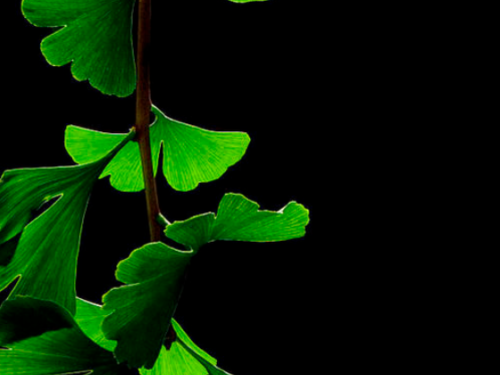
Ginkgo leaves in summer
The world of dwarf Ginkgo cultivars is reminiscent of the mythical American West, with the lawman not always successful in dealing with those vigilantes and renegades who abound on the frontier of new plant introductions. Upstanding growers, plant breeders and enforcement organizations try vainly to provide order for collectors who, like the townsfolk in the movie High Noon, much to Gary Cooper’s dismay, secretly enjoy some of the disruptions which the outlaws bring.
This has made composing a list of “best of breed” dwarf Ginkgo more difficult than one might think. To the extent that readers are dissatisfied with the lack of specificity and clarity surrounding some of these suggestions, remember that unless collectors demand bonafides from retailers, and refuse to purchase without them, it will be difficult to halt the influx of incompletely documented plants into the market.
Many—if not most—growers and breeders are ethical, but there is little motivation for those who are at best sloppy and at worst dishonest to play by rules which collectors ignore. Does the draw of more offerings outweigh the confusion—and ultimately the disappointment—when a promised trait in a cultivar fails to materialize? Do those with small gardens or tight budgets enjoy wading through incomplete descriptions and conflicting information when selecting the cultivar for a choice location or container?
Remember, if we insist that plants which are distinctive from others be registered as new cultivars, with appropriate accompanying documentation, we could head to the nursery armed with the data, with which to choose the one likeliest to meet our criteria and please us the most. This dusty Western town could use some deputies!
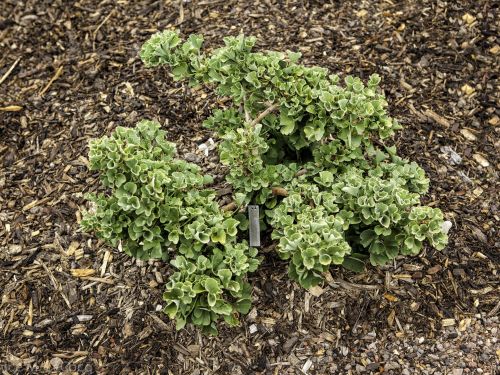
A conifer cousin, the Ginkgo biloba ‘Mariken.’ Photo by Janice M. LeCocq
Finding your right dwarf Ginkgo
Despite the challenges, we can still provide guidance in selecting a dwarf Ginkgo cultivar. If you want some degree of predictability, stick with those which have been around long enough and documented sufficiently to provide a reasonably clear idea of how the plant is going to perform. If you are more adventurous and want to explore the Ginkgo frontier, there are choices with less history which may tempt you. While the basic criteria for plant selection are more or less the same across genera, Ginkgo, due to the narrow range of characteristics discussed in Part I (one species, largely one sex, basically one color), really have only three attributes to consider: overall shape, size of plant and leaf shape/size.
Ordinarily, we would deem size to be the most important criterion, but these are all supposed to be dwarf varieties. Thus, in selecting one of these Ginkgo cultivars, it is generally most useful to first consider shape. Does the spot require a low spreader or a short, bushy plant? An upright, a vase-shaped or a columnar form? There are also pendulous versions, although most are not very weepy. Lucille Whitman, of Whitman Farms, a grower in Salem, Oregon, says that ‘Weeping Wonder’ is the best weeping form she’s seen. ‘Pendula’ and the others which purport to be weepers, really just have horizontal branches (Remember Richard Larson’s comment that “no Ginkgo is going to weep like a cherry.”).
A Look at Weeping Dwarf Ginkgos
Before you put ‘Weeping Wonder’ on your wish list, however, note that it is female, and if there is a male Ginkgo nearby, you may eventually get fruit. As we mentioned in Part I, fruit on a dwarf is unlikely to be particularly problematic, but caveat emptor. Richard Larson notes that ‘Weeping Wonder’ is a renaming of a plant which used to be called ‘Mutant Weeper’, and the plant eventually displays multiple morphologies, making its original name perhaps more useful!
‘Ross Moore’ is a more recent weeping introduction, but not much is known about it. So, we must wait to find out how it performs, and, since it was found as a growing tree, rather than as a broom on a sexed G. biloba, we as yet have no idea if it is a male or a female, or, indeed, how quickly it grows or how large it gets.
Size, indeed, is the second consideration in selection. Presumably those selecting dwarf cultivars are seeking small plants, but suggestions regarding size are famously defied—or at the very least, ignored—by collectors. With slow-growing plants such as Ginkgo, indeed it is the exceptional gardener who does not view size issues as the next owner’s—or even next generation’s—problem. Diane Van Anda, ISA certified arborist, says that proper size nomenclature and descriptions are often lacking in the nurseries and at the growers.

A conifer cousin, the Ginkgo biloba ‘Spring Grove.’ Photo credit Harold Greer of Greer Nurseries
What is a Dwarf Ginkgo Tree?
The American Conifer Society has adopted the following definition for dwarf conifers, which we can reasonably apply to Ginkgo: growth per year of 1 to 6”, approximate size at 10 years between 1 to 6’. ‘Dwarf’ size is flanked by “miniature” and “intermediate”, and many growers do use these terms. However, there is wild variation in how they define them, and some add ‘semi-dwarf’, which is not universally recognized. Although widely used on tags, 10-year size is only useful if one knows how old the specimen in question is at purchase. Since the vast majority of dwarf Ginkgo come to market as grafted clones, they are not starting at year one in the same way that a seed grown plant is. So remember, when selecting a dwarf Ginkgo variety, that size is yet another unknown aspect of many on the market, and, if you wait long enough, your lovely dwarf tree may outgrow its location.
The trade has a vested interest in underselling the size and growth rate of trees. As Diane explains: “Dwarf selections are increasingly being sought by landscape architects, designers and contractors as good choices for plant material in the urban landscape where smaller size is a desirable attribute.” Steven Courtney, Manager of Michigan State University’s Hidden Lake Gardens and Curator of its Harper Collection of Dwarf and Rare Conifers, offers a useful tip for those of us planting dwarf Ginkgo cultivars, the growth rates of which (and thus 10-year sizes) are unknown: root prune your plant every year, so that, if it outgrows its spot and you have to move it, the job will be less stressful for both you and the tree. Use a narrow-headed shovel (keep it sharpened) and stick it straight down around the plant on at least three sides.
Leafing Through Dwarf Ginkgo Tree Details
The third consideration in selecting a cultivar is leaf detail; some, such as ‘Jade Butterflies’ have leaves similar to the species. Others sport tiny leaves. Still others have leaves which are oddly formed or variable, such as ‘Thelma’ or ‘Tubifolia’. For many Ginkgo aficionados, the iconic leaf shape of the species is desirable and they shun—or at least do not favor—the variations on some of the dwarf cultivars. In speaking with collectors and growers, I heard more vehemence about leaf size and shape than about any other aspect of Ginkgo! Thus, with a relatively short list of attributes to consider, what do experts— and collectors—recommend among the nearly 30 dwarf cultivars currently being marketed in the U.S.?
When pressed for her favorites, Lucille, a pragmatist, focuses on selections which are distinctive, reliable and reasonably available. For those looking for nicely shaped choices with leaves similar to those of the species, she suggests ‘Spring Grove’, which is essentially vase-shaped, or ‘Mariken’, which grows in a compact, shrub-like fashion, but is sometimes grafted onto a stalk. ‘Chris’ Dwarf’ (syn. ‘Munchkin’) and ‘Chase Manhattan’ are her choices for “little bitty leaves”. ‘Tubifolia’ (often incorrectly styled ‘Tubiformis’) is a slightly bigger dwarf, to 6’ or so in 10 years, and has leaves which, on mature wood, are fused at the base into a trumpetshape which is distinctive, or, as she says, in her Southern drawl, “kinda cute”.
She finds ‘Troll’ aptly named, with heavy limbs which project at odd angles and ‘Thelma’ to be the strangest one she’s seen, with a fringed, split leaf. Crispin Silva, of Crispin’s Creations Nursery in Molalla, Oregon has been propagating Ginkgo for about 20 years, beginning with some of the older selections such as ‘Chase Manhattan’, which is still a favorite, of both his and his customers. Crispin has seen increased interest in dwarf Ginkgo on the part of the public; folks visiting his small operation come seeking Ginkgo along with other specialty trees such as Japanese maples, dogwoods and Styrax.

A conifer cousin, Ginkgo biloba ‘Tubifolia.’ Photo by Janice M. LeCocq
Favored Dwarf Ginkgo Tree Cultivars
Gary Handy, owner of Handy Nursery in Boring, Oregon, is willing to commit himself and term ‘Spring Grove’ the best dwarf, although he admits that he is viewing it from a grower’s perspective. ‘Spring Grove’ has a much fuller appearance as a young plant—even in a gallon container—than any other dwarf cultivar. Thus, a retail customer gets a fatter, denser plant, even when small. That, by itself, may be enough of a reason to begin one’s dwarf Ginkgo collection with ‘Spring Grove’; small Ginkgo have a way of looking like so many sticks initially, with little in the way of branching. ‘Spring Grove’ is also more uniform in growth habit than others, such as ‘Jade Butterflies’ or ‘Witch’s Broom’, which can be more irregular. Gary admits that some people prefer such irregular shapes, so that it largely comes down to personal preference.
Richard Larson is also a ‘Spring Grove’ fan, but cautions that it should probably be termed an intermediate rather than a dwarf. He describes one that was planted in 1998 which is now about 10’ tall. He too likes ‘Mariken’, which he describes as “well behaved, low and compact and retains its compact status well”. He cites ‘Troll’ as another favorite. After 12 years his plant similarly has stayed compact and well behaved. Its name comes from its short, stubby branches which Lucille described as ‘heavy’.
Ironically, ‘Jehosephat’ (originally named Spring Grove #86), which Richard registered himself, has not lived up to his expectations, which should serve as a cautionary tale to all; he observed it for 12 years, after which the plant was still not even up to his knees. He then registered it, and shortly thereafter, following a mild, wet summer it “scooted up” to where it is virtually identical to ‘Spring Grove Sport’. If a diligent observer who believes in the integrity of the registration process can have this experience, what does that say about the reliability or differentiation of unregistered Ginkgo cultivars?
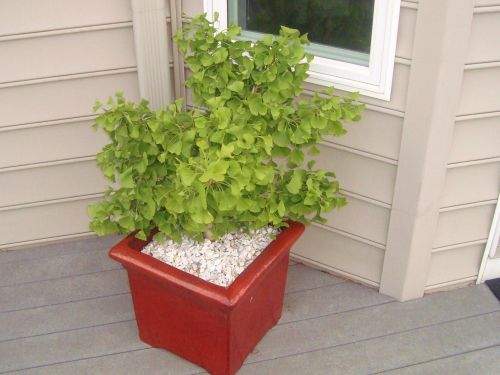
A conifer cousin, Ginkgo biloba ‘WB’
Steven Courtney’s favorites are ‘‘Jehosephat’, ‘Witch’s Broom’/‘WB’ and ‘Munchkin’ (syn ‘Chris’ Dwarf’). He likes the very full appearance of ‘Jehosephat’, which has leaves about half the size of the species. The densely-leaved, globe-shaped plant has very full branching so that the overall effect is one of lushness. ‘WB’ has stayed true to expectations—that is, quite dwarf—in his garden, where it has been growing for about five years. His sandy soil does not favor rapid growth, so that may be a contributing factor. He likes ‘Munchkin’ for its shape, which is broad and spreading, and for its tiny leaves. For tiny-leaved fans, it is worth noting that ‘Munchkin’/’Chris’ Dwarf’ has the smallest leaves of any Ginkgo.
Byron Baxter, who operates a small specialty nursery in Ohio, favors ‘Chi Chi’, syn. ‘Tschi Tschi’, which some label an intermediate. He specializes in conifers and niche plants not offered by many of the bigger growers; even though ‘Tschi Tschi’ is an older cultivar, and many more dwarfs have been introduced since it became available. He says that it fills a place in the landscape perfectly. “It is that perfect fit which makes both the tree and me happy. If only all of my plantings over the years had been sited as such, my gardens would be much better. Live and learn.”
Thoughts from Dwarf Ginkgo Tree Collectors
Collectors, not surprisingly, have their own opinions of which cultivars represent the “best of breed." Dave Stegmaier in Shawnee, Kansas, an avid collector of specimen conifers which he interplants with deciduous trees and shrubs, has a number of dwarf Ginkgo and favors ‘Jade Butterflies’. While he cautions that it is not a “stand alone, focal point” tree, it is an attention-getter all year round, with its dark-green butterfly-shaped leaves in spring and summer and its distinctive bark and vertical limbs in winter. Then, of course, there is the buttery-yellow fall color!
Jan Curry, who gardens in the San Francisco Bay Area, is so taken with ‘Mariken’, that, despite a small garden chock-a-block with specimen conifers and other intriguing shrubs and small trees, she is looking to find a place to plant a second one! ‘Mariken’ meets her criteria for being both small and interesting, and she likes its low, shrubby form. Jan is a perfect example of a collector who values some predictability in her selections; her garden is simply not large enough to accommodate failed choices or plants which grow faster or larger than they are supposed to.
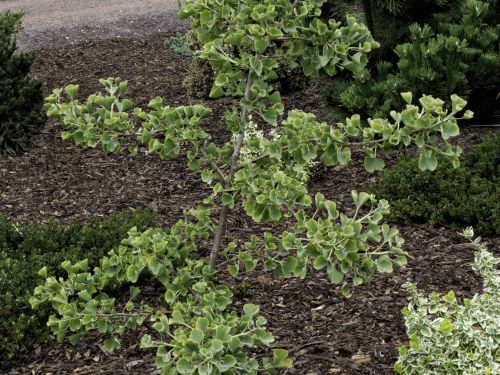
A conifer cousin, Ginkgo biloba ‘Jade Butterflies’
Alan Twohig in Chesapeake, Maryland grows about half a dozen different cultivars, including ‘Munchkin’ (syn. ‘Chris’ Dwarf’), ‘Chase Manhattan’, ‘Troll’, ‘Jade Butterflies’ and ‘Mariken’. He has a ‘Witch’s Broom’/’WB’ in a container in a choice location by his front door. Dwarf trees are often wonderful candidates for containers and Ginkgo cultivars are no exception. Al admits that he may have to move it into the ground at some point, but for now it makes a lovely, eye-catching focal point on his porch. It lives there year-round, with winter interest provided by its interesting scaffolding. Al grew Japanese maples for about 20 years and notes that the dwarf Ginkgo make a great alternative to maples for a small deciduous tree amongst conifers, especially in smaller gardens with limited space. Al, who, like Jan, has a small garden, has stuck with the better-documented cultivars to avoid giving over prime garden real estate to plants which may prove disappointing.
This author has about 10 dwarf Ginkgo and finds ‘Todd’s Dwarf’ and ‘Mariken’ the most pleasing, largely due to the attractive branching and overall structure of the plants. I have to admit that I like the small leaves of ‘Chase Manhattan’ and the furled ones of ‘Tubifolia’. Wanting more predictability, I have stuck with the tried and true, but confess that the descriptions of ‘Beijing Gold’, despite being inconsistent, intrigued me so much that I purchased a small plant this year and am looking forward to seeing the leaf color for myself. I am also intrigued by descriptions of some of the spreading forms, such as ‘Girard’s Spreader’ and ‘Layin Low’, and the weeper ‘Ross Moore’, but cannot find out much about them—or indeed locate the plants for sale—so, I will leave those for others to try.
A conifer cousin, Ginkgo biloba ‘Todd’s Dwarf.' Photo by Janice M. LeCocq
New Dwarf Ginkgo Tree Cultivars
For those of you who want to hunt for the very latest, in fact, one still in the “laboratory”, Byron Baxter, the Ohio tree buff, tells of liners he received some years ago for ‘Tubifolia’ (syn. ‘Tubeleaf’, ‘Tubiformis’). They grew as expected except for one, which never sent up a leader, and is now about 18” tall and 5’ wide. He grafted some of the wood in 2011, expecting it to revert and grow like the others, but all the grafts grew laterally—not a single one put up a leader. The trees grow laterally for about 3-4’ and then arch down to the ground.
Byron, who is the registrar for ‘Queen City’, one of the ‘Spring Grove’ witch’s brooms, sent in a registration for his find, calling it ‘Golden Arches’. An ACS member touring last summer pointed out that since the understock is short (18” or so), it is hard to know if the shape is really arched or only pendulous. Byron plans to graft onto higher understock this year to determine the ultimate shape of the tree. However, we may have to wait a while to learn the results: it turns out that scion wood is not the only wood which is in short supply in the world of Ginkgo grafts! Understock is not exactly prevalent, either.
When looking for three-foot understock for his high grafts, Byron could not find any. Thus, he is doing it the old-fashioned way and growing his own. Ginkgo futures, anyone? Dave in Shawnee, when searching for the best words to describe why he loves and enjoys Ginkgo, let the poet Howard Nemerov do it for him:
The Consent (by Howard Nemerov)
Late in November, on a single night
Not even near to freezing, the ginkgo trees
That stand along the walk drop all their leaves
In one consent, and neither to rain nor to wind
But as though to time alone: the golden and green
Leaves litter the lawn today, that yesterday
Had spread aloft their fluttering fans of light.
What signal from the stars?
What senses took it in?
What in those wooden motives so decided
To strike their leaves, to down their leaves,
Rebellion or surrender? and if this
Can happen thus, what race shall be exempt?
What use to learn the lessons taught by time.
If a star at any time may tell us: Now.
So, if you’re not growing at least one dwarf Ginkgo cultivar, what are you waiting for? The time is Now! Click here to read Sara's introduction to Ginkgo biloba and here to learn about variegated G. biloba.
This post has not been tagged.
Permalink
|
|
|
Posted By Administration,
Thursday, June 8, 2023
|
By Sara Malone
May 31, 2021
10 Types of Spruce Trees Everyone Should Know

Colorado Blue Spruce (Picea pungens)
To most people, 'conifer' and 'pine tree' are synonymous. There is some rationale for this, as the pine family is the largest conifer family and what we call pines, firs and spruces are all pine family members. So what, exactly, is a spruce tree? Are spruces all trees? How are they different from pines and other conifers? And what are 10 of the most interesting types of spruce trees for the home garden and landscape?
The easiest ways to distinguish spruces from firs is the way mature seed cones are held in the tree. In spruces (Picea species) mature seed cones hang from the branches and will fall intact from tree while in firs (Abies species), mature cones are held upright on the branches and will disintegrate rather than falling intact.
Needles are also a distinguishing factor. Pine (Pinus species) needles grow in bundles (fascicles) of 1 to 5 needles, while spruces and firs are attached singly. Those with sharp eyesight will also notice that spruce needles are attached to a branch by a tiny peg (pulvinus), while fir needles are attached directly to the stem with what appears to be some sort of suction cup.
Oriental Spruce
Spruces can be shrubs, small trees, or very large trees indeed. The average homeowner should focus on the dwarf and miniature selections that fit better into the home landscape. The Picea orientalis 'Early Gold' pictured above, for example, is about 6 feet (2 m) tall after 10 years, has orderly, delicate needles and attractive, slightly weeping branches. And those seed cones!

Picea orientalis 'Skylands' at the Mendocino Coast Botanical Gardens
Picea orientalis 'Skylands' is another oriental spruce tree; its distinctive feature is its lovely golden foliage. 'Skylands' should be protected from hot afternoon sun on summer's longest days or it will burn. If 'Skylands' gets too big for your garden, there is a select "Skylands seedling" called 'Firefly' that displays the same golden foliage, but grows more slowly and stays smaller.
Colorado Spruce

Picea pungens (Colorado blue spruce) 'Lucretia'
The Colorado blue spruce (Picea pungens) is probably responsible for more conifer distaste (if not downright hatred) than any other conifer. That's because the wild trees that grow in nature get enormous! Unfortunately, too many developers and landscapers unwittingly planted small, young specimens right in front of houses. In just a few years the trees towered over the dwellings and covered the windows. However, there are many, many dwarf varieties and their color is stunning in the landscape. Look at how Picea pungens 'Lucretia', pictured above, contrasts with the purple leaves of the smoke bush (Cotinus) in the background. 'Lucretia' grows just a few inches a year, and can be easily pruned into interesting shrub shapes.

Lucretia's brilliant blue needles are echoed by the equally dramatic color of P. pungens 'Fat Albert' in the distance
If you want a more traditional spruce tree shape, consider a cultivar like Picea pungens 'Fat Albert', which has the cone-shape that most people associate with conifers, albeit in a much smaller size than the native behemoths. Albert gets to be about 10 to 15 feet (3 to 5m) tall after 10 years in the landscape, and true to its name, is wide at the base.
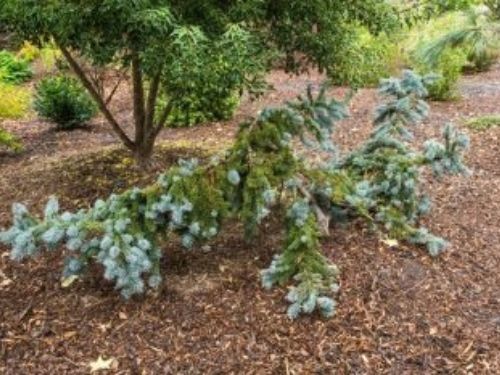
'Pendula' Colorado spruce - conifer or sculpture?
There are other Colorado spruces that grow in quirky fashion, which pruning can enhance, such as Picea pungens 'Pendula'. Loch Ness Monster, anyone? And 'Pendula' produces some pretty special seed cones, rivaling those Picea orientalis 'Early Gold':

Seed cones on Picea Pungens 'Pendula'
There are also Colorado spruces that have golden or creamy new needles, like Picea pungens 'Gebelle's Golden Spring'. These are typically slower growing than the species trees. Their new growth is as showy as any of the spring flowers!

Picea pungens 'Gebelle's Golden Spring'
Norway Spruce
Another very common spruce is the Norway spruce, or Picea abies. In nature, these trees are very large, with very dark green needles on gracefully weeping branches. But cultivars for the garden abound; this may be the most prolific spruce there is! Some also have golden needles, such as Picea abies 'Aurea Magnifica'.

Picea abies 'Aurea Magnifica' at Circle Oak Ranch in California.
Others have tiny pink seed cones that look like rosebuds:

Picea abies 'Pusch' cones...or are they rosebuds?
Picea abies 'Pusch' is a small plant that grows in a globe shape at the rate of about 2 inches (5 cm) per year. Those springtime seed cones are as decorative as flowers. It originated as a witch's broom (bud mutation) on Picea abies 'Acrocona', another lovely spruce.
Some Norway spruce cultivars even have red needles! The new growth on Picea abies 'Rubra Spicata' is rosy and then matures to green:
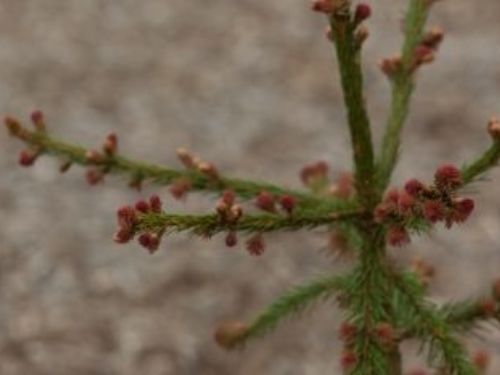
Picea abies 'Rubra Spicata'
There are also many weeping Norway spruces. Weeping specimens add a different dimension to the landscape. Some of them look like creatures!

Norway Spruce (Picea abies)
These are 10 of the most striking spruces, but they represent only three of the almost 40 species of spruce! Imagine how many other lovelies are lurking in this genus. The ACS Conifer Database has the full story.
So add color, year-round interest, texture and structure to your garden by planting some dwarf conifers! join the American Conifer Society to learn more about conifers and to connect to a nationwide group of plant lovers! You'll get discounts at nurseries, access to rare and unusual plants, and have a ton of fun!
This post has not been tagged.
Permalink
|
|
|
Posted By Administration,
Thursday, June 8, 2023
|
By Web Editor
March 20, 2021
How to Prevent Arborvitae Deer Damage
Because arborvitaes are a favorite cool- and cold-weather food source for deer, homeowners need to be proactive in implementing deer-management strategies if they wish to keep deer away from their trees.
Text and Photography Jennifer Smith, Deerbusters Deer Fence

Closeup of plastic-coated deer fencing
Arborvitaes (Thuja occidentalis) are a favorite conifer species to plant as ornamental trees and hedges. While some homeowners may use them for privacy screening, the tall, vibrant trees are known to attract nosy, marauding deer. Thuja occidentalis is sweet-tasting snack for white-tailed deer that will strip bare the bark and leaves from the trees as high up as they can reach. Because arborvitaes are a favorite cool- and cold-weather food source for deer, homeowners need to be proactive in implementing deer-management strategies if they wish to keep deer away from their trees.
Deer Repellents
Gardeners often turn to deer repellents at the first signs of deer-damaged arborvitae. The reasoning is simple. Deer repellents are inexpensive, easy to use, and effective – that is, for a brief time. The odorous deer repellents can drive white-tailed deer away from gardens for several months. However, during changing weather patterns, do we re-apply the repellent or not? This becomes a guessing game for home gardeners and a chore rather than a no-hassle deterrent. While the initial cost of repellents is attractive to homeowners, they are more effective as secondary forms of protection along the perimeter of a deer fence rather than as primary deterrents.
Deer Fencing
Deer fencing is the most-effective means for deer control and is also credited with reducing the risk and spread of Lyme Disease by 83 to 97 percent (National Center for Biotechnology Information). This is especially significant for homeowners trying to mitigate the disease and keep it away from small children and pets. Many types of fence exist on the market.
Wooden fences are elegant, but costly, and deer can jump over them. Chain-link fences are a popular choice by pet owners, but most homeowners will admit that they are not aesthetically pleasing. Besides, the initial cost of materials and the price tag associated with installation by certified fence installers are high. In addition, a single line of fence, if not high enough, will require a second line of fence to keep the deer at bay. Both lines will also need to be electrified. Hungry animals will probe any barrier to find a way in. Electrified fencing is not recommended if there is a danger that humans will come into contact with it.
The best height for deer fence is 7 1/2 to 8 feet high. The reason is that deer have poor eyesight (20/100 in the daytime) and are not comfortable taking a leap of faith if they cannot see the other side of where they hope to land. As it turns out, the most cost-effective and efficient deer fencing is made of plastic.
When To Use Plastic Deer Fence
The word “plastic” has a bad reputation as something that is flimsy and cheap. However, the material is lightweight and easy to handle, making it a great weekend install project for DIY’ers. Plastic deer fence is also durable, with breaking strengths ranging from 650 to 1,400 pounds and a life expectancy of up to 20 years. Plastic fence can also be easily produced in tall heights at reasonable costs. This fence type is meant for light to moderate deer populations, but not recommended for gardeners dealing with chewing animals.

Plastic-coated deer fence (Amor-Flex) in Eastern Shore, MD
When To Use Metal Deer Fence
Metal fences are popular among gardeners for several reasons. They are stronger than plastic fences, hold up longer in the environment, and are chew-resistant against wildlife. Metal fences are mostly used by chicken owners to keep coyotes away from the flock. While they serve well for livestock management, they are missing a key element that should be considered when shopping for a metal deer fence, PVC-coating.
Steel deer fences that are covered in PVC are recommended for gardeners dealing with chewing animals and heavy deer pressure. The PVC also acts as a secondary layer of protection on the fence, blocking chew marks by wild animals and rust caused by dry and damp climates. Metal deer fences last 10 to 20 years longer than plastic fences.

Armor-Flex fence used in the Cleveland, OH, Metro Parks
Deer-Resistant Plants To Grow
Deer-resistant plants are essential no matter the fence type. They include perennial flowers and herbs that have a pungent fragrance and a taste that deer can’t abide. Gardeners should plant deer-resistant flowers on the outside perimeter of deer fences as another line of deterrence. Some of the most effective plants to grow for deer resistance include peonies (Paeonia), daffodils (Narcissus), iris (Iris), calliopsis (Coreopsis tinctora), marigolds (Tagetes), sage (Salvia), and garlic (Allium sativum). Western arborvitae, also known as western red-cedar (Thuja plicata), is a cold-hardy tree that is also deer-resistant!
Final Thought
Arborvitaes are a favorite food for deer in the fall and winter months; not just to eat, but to use during deer-rutting season. The most cost-effective deer fencing with the easiest install is the plastic deer fence. A popular fence with nurseries, parks, and arboreta, plastic fence is the best, first line of defense to keep deer away from your arborvitae. We can even go beyond just protecting arborvitae to include all conifers. Since all conifers are susceptible to deer damage, plastic fence is the best fence remedy. Deer-resistant plants and deer repellents make up this three-pronged punch to combat deer damage. All good things come in threes.
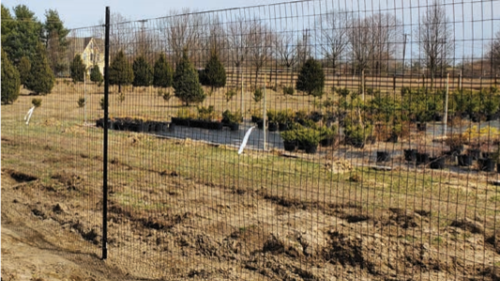
R. Smith Nursery, Medford, NJ, uses plastic-coated deer fence
This post has not been tagged.
Permalink
|
|
 WR President
WR President SER President
SER President SER Director
SER Director WR Director
WR Director ACS President
ACS President ACS Secretary
ACS Secretary ACS Treasurer
ACS Treasurer CR Director
CR Director CR President
CR President